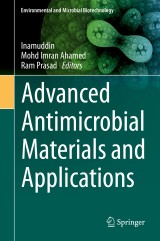Details

Advanced Antimicrobial Materials and Applications
Environmental and Microbial Biotechnology
|
234,33 € |
|
| Verlag: | Springer |
| Format: | |
| Veröffentl.: | 04.11.2020 |
| ISBN/EAN: | 9789811570988 |
| Sprache: | englisch |
Dieses eBook enthält ein Wasserzeichen.
Beschreibungen
<div><div>Surface bio-contamination has become a severe problem that contributes to outbreaks of community acquired and nosocomial infections through contiguous fomite transmission of diseases. Every year, thousands of patients die due to nosocomial infections by pathogens. It is therefore essential to develop novel strategies to prevent or improve the treatment of biomaterial concomitant infections. </div><div>The concept of antimicrobial materials is becoming increasingly important not only in the hospital and healthcare environments, but also for laboratories, home appliances, and certain industrial applications. Materials are now being developed to prevent the buildup, spread and transfer of harmful microbes, and to dynamically deactivate them. Drawing on research and examples from around the world, this book highlights the latest advances in, and applications of, antibacterial biomaterials for biomedical devices, and focuses on metals with antibacterial coatings/surfaces, antibacterial stainless steels and other commonly used antibacterial materials. It also discusses the role of innovative approaches and provides a comprehensive overview of cutting-edge research on the processing, properties and technologies involved in the development of antimicrobial applications. Given its scope, the book will be of interest to researchers and policymakers, as well as undergraduate and graduate students of biochemistry, microbiology, and environmental chemistry</div></div><div><br></div><p></p>
<div>Chapter 1. Antimicrobial polymers.- Chapter 2. Starch based antimicrobial materials.- Chapter 3. Cellulose-based antimicrobial materials.- Chapter 4. Polymerized ionic liquids as antimicrobial materials.- Chapter 5. Silver composites as antimicrobial materials.- Chapter 6. Natural antimicrobial materials.- Chapter 7. Advanced antimicrobial materials and applications.- Chapter 8. Antimicrobial magnetic nanoparticles: A potential antibiotic Agent in The Era of multi-drug resistance.- Chapter 9. Antifungal, antimycotoxigenic, and antioxidant activity of essential oils and medicinal plant extracts.- Chapter 10. Antibacterial Electrospun nanofibres.- Chapter 11. Plant extracts: antimicrobial properties, mechanisms of action and applications.- Chapter 12. Antimicrobial materials for local drug delivery.- Chapter 13. Antimicrobial membranes for water treatment.- Chapter 14. Antimicrobial fillers for dental restorative materials.- Chapter 15. Molecular imprinting technology: A new approach for antibacterial materials.</div>
<p>Dr. Inamuddin, Ph.D., is an Assistant Professor at the Chemistry Department, King Abdulaziz University, Jeddah, Saudi Arabia and also an Assistant Professor at the Department of Applied Chemistry, Aligarh Muslim University, Aligarh, India. He has extensive research experience in the fields of analytical chemistry, materials chemistry, electrochemistry, renewable energy and environmental science. He has published ca. 150 articles in various international scientific journals, 18 book chapters, and 83 edited books. His current research interests include ion exchange materials, a sensor for heavy metal ions, biofuel cells, supercapacitors and bending actuators.</p><p>Dr. Mohd Imran Ahamed received his Ph.D. degree on the topic of “Synthesis and characterization of inorganic-organic composite heavy metals, selective cation-exchangers and their analytical applications” from Aligarh Muslim University, Aligarh, India in 2019. He has published several research and review articles in prominent international journals. Holding a B.Sc. (Hons) in Chemistry from Aligarh Muslim University, Aligarh, India, and an M.Sc. in Organic Chemistry from Dr. Bhimrao Ambedkar University, Agra, India, his research interests include ion-exchange chromatography, wastewater treatment and analysis, bending actuators and electrospinning.</p><p>Dr. Ram Prasad is currently working as an Associate Professor at the Department of Botany, Mahatma Gandhi Central University, Motihari, Bihar, India. Dr. Prasad previously served as an Assistant Professor at Amity University, Uttar Pradesh, India; Visiting Assistant Professor at Whiting School of Engineering, Department of Mechanical Engineering at Johns Hopkins University, USA; and Research Associate Professor at the School of Environmental Science and Engineering, Sun Yat-sen University, Guangzhou, China. Dr. Prasad has more than one hundred fifty publications to his credit, including research papers, review articles & book chapters; has edited or authored several books; and has five patents issued or pending. His research interests include applied microbiology, plant-microbe interactions, sustainable agriculture and nanobiotechnology.</p><div><br></div>
Surface bio-contamination has become a severe problem that contributes to outbreaks of community acquired and nosocomial infections through contiguous fomite transmission of diseases. Every year, thousands of patients die due to nosocomial infections by pathogens. It is therefore essential to develop novel strategies to prevent or improve the treatment of biomaterial concomitant infections. <div>The concept of antimicrobial materials is becoming increasingly important not only in the hospital and healthcare environments, but also for laboratories, home appliances, and certain industrial applications. Materials are now being developed to prevent the buildup, spread and transfer of harmful microbes, and to dynamically deactivate them. Drawing on research and examples from around the world, this book highlights the latest advances in, and applications of, antibacterial biomaterials for biomedical devices, and focuses on metals with antibacterial coatings/surfaces, antibacterial stainless steels and other commonly used antibacterial materials. It also discusses the role of innovative approaches and provides a comprehensive overview of cutting-edge research on the processing, properties and technologies involved in the development of antimicrobial applications. Given its scope, the book will be of interest to researchers and policymakers, as well as undergraduate and graduate students of biochemistry, microbiology, and environmental chemistry.</div><div><br></div>
Elaborates on recent advances in microbial derived nanomaterials for antimicrobial applications Highlights recent trends in antimicrobial biomaterials for clinical uses Introduces readers to plant-based antimicrobial biomaterials
Diese Produkte könnten Sie auch interessieren:

Tropical and Parasitic Infections in the Intensive Care Unit

von: Charles Feldman, George A. Sarosi

149,79 €















